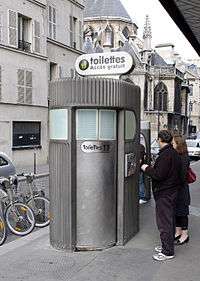Public toilet
A public toilet is a room or small building with one or more toilets (or urinals) available for use by the general public, or by customers or employees of a business. Public toilets are commonly separated into male and female facilities, although some are unisex, especially for small or single-occupancy public toilets. Increasingly, public toilets are accessible to people with disabilities. Public toilets are known by many other names depending on the country. Examples are: "restroom," "washroom," "bathroom," "water closet" (W.C), "comfort room," and "ladies'/women's room" and "gents'/men's room."
Some public toilets are free of charge while others charge a fee. In the latter case they are also called pay toilets and sometimes have of a coin-operated turnstile.
Local authorities or commercial businesses may provide public toilet facilities. Some are unattended while others are staffed by an attendant. In many cultures, it is customary to tip the attendant, especially if they provide a specific service, such as might be the case at upscale nightclubs or restaurants.
Public toilets are typically found in schools, offices, factories, and other places of work. Similarly, museums, cinemas, bars, restaurants, entertainment venues usually provide public toilets. Railway stations, filling stations, and long distance public transport vehicles such as trains, ferries, and planes usually provide toilets for general use. Portable toilets are often available at large outdoor events. In many Asian, African, and countries heavily influenced by Muslim cultures, public toilets are of the squat type, as this is regarded as more hygienic for a shared facility.
Alternative names
.jpg)

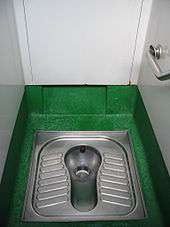
.jpg)
.jpg)
Public toilets are known by many names in different varieties of English. In American English, "restroom" usually denotes a toilet facility designed for use by the public; however, "bathroom" is also common. "Comfort station" sometimes refers to a visitor welcome center such as those in national parks.
In Canadian English, public facilities are frequently called "washrooms", although usage varies regionally. The word "toilet" generally denotes the fixture itself rather than the room. The word "washroom" is rarely used to mean "utility room" or "mud room" as it is in some parts of the United States. "Bathroom" is generally used to refer to the room in the home that contains a bath or shower.
In Britain, Australia, Hong Kong, Singapore, and New Zealand, the terms in use are "public toilet", "public lavatory" (abbreviated "lav"), "public convenience", and more informally, "public loo". A "bathroom" is a room containing a bath, a "washroom" is a room for washing hands, and a "restroom" is a room to rest in when tired; none of which would necessarily contain a toilet. As public toilets were traditionally signed as "gentlemen" or "ladies", the colloquial terms "the gents' room" and "the ladies' room", or simply "the gents" and "the ladies" are used to indicate the facilities themselves. The British Toilet Association, sponsor of the Loo of the Year Awards, refers to public toilets collectively as "away-from-home" toilets.[1]
In Philippine English, "comfort room", or "C.R.", is the most common term in use.[2]
Some European languages used words cognate with "toilet" (e.g. les toilettes in French), or the initialism "W.C.", an abbreviation for "water closet", an older term for the flush toilet. Public urinals (pissoir) are known in several Romance languages by the name of a Roman Emperor: vespasienne in French, vespasiani in Italian, and vespasiene in Romanian.[3]
Mosques, madrassas (schools), and other places Muslims gather, have public sex-segregated "ablution rooms" since Islam requires specific procedures for cleansing parts of the body before prayer. These rooms normally adjoin the toilets, which are also subject to Muslim hygienical jurisprudence and Islamic toilet etiquette.
Types
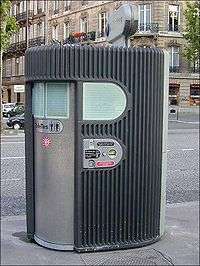
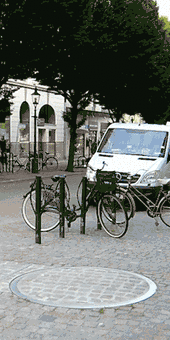
Many public toilets are permanent small buildings visible to passers-by on the street. Others are underground, including older facilities in Britain and Canada. Contemporary street toilets include automatic, self-cleaning toilets in self-contained pods; an example is the Sanisette, which first became popular in France.[4] An Indian version of these automated toilet pods, remotely monitored by sensors, are the Electronic Public Toilets or eToilets; they have proliferated across the country since 2014, as part of Swachh Bharat Abhiyan, the campaign launched that year to end open defecation.[5]
Another traditional type that has been modernized is the screened French street urinal known as a pissoir (vespasienne). An updated cylindrical urinal that lowers beneath street level out of the way and pops up during hours when it is needed is the Urilift Pop Up Urinal.[6] It is typically installed in entertainment districts and is operational only during weekends, evenings and nights. This urinal brand, invented in the Netherlands, also offers a pop-up toilet for women.[6]
Private firms may maintain permanent public toilets. The companies are then permitted to use the external surfaces of the enclosures for advertising. The installations are part of a street furniture contract between the out-of-home advertising company and the city government, and allow these public conveniences to be installed and maintained without requiring funds from the municipal budget.
Various portable toilet technologies are used as public toilets. Portables can be moved into place where and when needed and are popular at outdoor festivals and events. A portable toilet can either be connected to the local sewage system or store the waste in a holding tank until it is emptied by a vacuum truck. Portable composting toilets require removal of the container to a composting facility.
The standard wheelchair-accessible public toilet features wider doors, ample space for turning, lowered sinks, and grab bars for safety. Features above and beyond this standard are advocated by the Changing Places campaign.[7] Features include a hoist for an adult, a full-sized changing bench, and space for up to two caregivers.
Purposes
As an "away-from-home" toilet room, a public toilet can provide far more than access to the toilet for urination and defecation. People also wash their hands, use the mirrors for grooming, get drinking water (e.g. refilling water bottles), attend to menstrual hygiene needs, and use the waste bins. Public toilets may also become places for harassment of others or illegal activities, particularly if principles of Crime prevention through environmental design (CPTED) are not applied in the design of the facility.
Health aspects
Public toilets play a role in community health and individual well-being. Where toilets are available, people can enjoy outings and physical activities in their communities. By letting people get out of their cars and onto their feet, bicycles and mass transit, public toilets can contribute to improved environmental health. Mental well-being is enhanced when people are out with families and friends and know a place "to go" is available.
Public toilets serve people who are "restroom challenged".[9] First, some people need to go very frequently, including young and old people, females who are pregnant or menstruating, and those with some medical conditions. Second, some people need toilet access urgently, suddenly and without warning: such as those with chronic conditions such as Crohn's disease and colitis, and those temporarily afflicted with food-borne illnesses.[9]
The inability to satisfy essential physiological needs because no toilet is available contributes to health issues such as urinary tract infections, kidney infections, and digestive problems which can later develop into severe health problems.[8] Inadequate access to a restroom when required can lead to substantial problems for men with prostate problems, women who are menstruating or going through the menopause and anyone with urinary and fecal incontinence.
If bus and truck drivers on timed schedules have difficulty in accessing toilets, this puts them risk of bladder and digestive health problems. Furthermore, if the concentration of a driver in urgent need is compromised, it becomes a broader public safety concern.
Workers therefore have legal rights to access a toilet during their work day. In the United States, the Department of Labor's Occupational Health and Safety protects workers' rights to toilet breaks because of the documented health risks.[9] This protected right to a toilet is a function of the workplace and is lost when workers leave the workplace.[10]
According to the Government of Australia, more than 3.8 million Australians of all ages are estimated to suffer continence issues.[11] This represents 18% of the Australian population. Therefore, the Department of Health and Ageing maintains the National Public Toilet Map to enable the public to find the closest facility.
The public toilet is an essential element in a community's physical and social infrastructure, without which people cannot participate in their communities with dignity and confidence.
Design
Entry
Doorless entry
Modern public toilets may be designed with a labyrinth entrance (doorless entry), which prevents the spread of disease that might otherwise occur when coming in contact with a door. Doorless entry provides visual privacy while simultaneously offering a measure of security by allowing the passage of sound. Doorless entry also helps deter vandalism; fewer audible clues to another person entering discourages some vandals. Doorless entry may also be achieved simply by keeping an existing door propped open, closed only when necessary.
Coin operated entry
Pay toilets usually have some form of coin operated turnstile, or they have an attendant who collects the fee.
Service access
Modern public toilets often have a service entrance, utilities passage, and the like, that run behind all the fixtures. Sensors are installed in a separate room, behind the fixtures. Usually the separate room is just a narrow corridor or passageway.
Sensors
Sensor-operated fixtures (faucets, soap dispensers, hand dryers, paper towel dispensers) prevent the spread of disease by allowing patrons to circumvent the need to touch common surfaces. Sensor-operated toilets also help conserve water by limiting the amount used per flush, and require less routine maintenance. Each sensor views through a small window into each fixture. Sometimes the metal plates that house the sensor windows are bolted on from behind, to prevent tampering. Additionally, all of the electrical equipment is safely behind the walls, so that there is no danger of electric shock. However, a RCCB must be used for all such electrical equipment.
Lighting
Service lighting consisting of windows that run all the way around the outside of the toilet using electric lights behind the windows, to create the illusion of extensive natural light, even when the toilets are underground or otherwise do not have access to natural light. The windows are sometimes made of glass brick, permanently cemented in place. Lighting installed in service tunnels that run around the outside of the toilets provides optimum safety from electrical shock (keeping the lights outside the toilet), hygiene (no cracks or openings), security (no way for vandals to access the light bulbs), and aesthetics (clean architectural lines that maintain a continuity of whatever aesthetic design is present, e.g., the raw industrial urban aesthetic that works well with glass brick).
Cisterns (tanks)
Older toilets infrequently have service ducts and often in old toilets that have been modernized, the toilet cistern is hidden in a tiled over purpose-built 'box'. Often old toilets still have high-level cisterns in the service ducts. On the outside, the toilet is flushed by a handle (just like an ordinary low-level cistern toilet) although behind the wall this handle activates a chain. Sometimes a long flushing trough is used to allow closets to be flushed repeatedly without waiting for the cistern to refill. This trend of hiding cisterns and fittings behind the walls started in the late 1930s in the United States and in the United Kingdom from the 1950s, and by the late 1960s it was unusual for toilet cisterns to be visible in public toilets. In some buildings such as schools, however, a cistern can still be visible, although high-level cisterns had become outdated by the 1970s. Many schools now have low-level cisterns.
Fixtures
Public toilets by their nature see heavy usage, so they may rely on a flushometer with a stronger and louder flush than a home toilet. Some high-vandalism settings, such as beaches or stadiums, will use metal toilets. Public toilets generally contain several of the following fixtures.
In the lockable cubicle (stall)
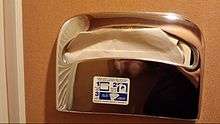
- Toilet with toilet seat; whereas a home toilet seat has a lid, a public toilet may or may not
- Toilet paper, often within a lockable dispenser
- Coat hook
- "Pull-down" purse holder
- Sanpro bin for menstrual products; this may be classified as clinical waste and be subject to special regulations concerning disposal
- Dispenser for flushable paper toilet seat covers
At the point of handwashing
- Faucets (taps), note some are at a lower level for children and wheelchair users
- Antiseptic handwash dispenser or soap dispensers, pump bottles or auto dispensers
- Mirror (usually over sinks)
- Paper towel dispenser (sometimes they have auto-sensors for touchless dispensing)
- Garbage can (a rubbish bin)
- Hand dryer (used manually or with auto-sensors)
Elsewhere
- Urinals (almost exclusively in men's and boys' bathrooms; although see female urinal)
- Vending machines dispensing condoms, diapers (nappies), painkillers, energy drinks, perfume, breath mints, facial tissue, confectionery, undergarments, swimwear, soap, sex toys, or sanitary napkins or tampons
- Air fresheners or odour control systems
- Infant changing table, often fold-down (usually in women's rooms, but increasingly in men/s rooms, due to legal changes[12])
- Sometimes showers are also present, often with soap, shampoo, or similar dispensers (often at truck stops)
Costs and economics
User fees
Toilets that require the user to pay may be street furniture or be inside a building, e.g. a shopping mall, department store, or railway station. The reason for charging money is usually for the maintenance of the equipment. Paying to use a toilet can be traced back almost 2000 years, to the first century AD. The payment may be taken by a bathroom attendant, or by a coin-operated turnstile or cubicle door (see John Nevil Maskelyne, who invented a doorlock requiring the insertion of a penny coin, hence the euphemism to "spend a penny".[13]) The first pay toilet in the United States was installed in 1910 in Terre Haute, Indiana.[14]
Privatization and closures
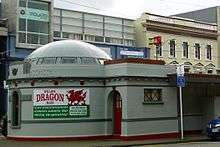
In some places, the provision of public toilet facilities is under great pressure.[15][16] One response by public authorities is to close the buildings, often citing criminal activity.[17][18] The United Kingdom government austerity programme has led to major council cut-backs to public toilet provision, with knock-on effects on the public realm as a whole.[19] Some of the buildings, particularly the underground ones, are sold and used for other purposes, e.g. as a bar.
Another response is to privatise the toilets, so that a public good is provided by a contractor,[20] just as private prisons are. The toilets may fall under the category of privately owned public space - anyone can use them, but the land ultimately belongs to the corporation in question. When toilets that have been privatised are improperly run, or closed, there may be calls to take them back into the control of the public authority, as with Westminster Council in central London - one of the wealthiest places in the world, where members of the public are reduced to urinating in the parks and streets for lack of available facilities.[21]
Toilets for customers
Customers often expect retail stores and shopping centres to offer public toilets. Customers rank complimentary toilets highly, and their availability influences shopping behaviour. By offering appropriate customer toilets, retail stores and shopping centres may enhance their profits and image; however, many retailers pay insufficient attention to their customer toilet facilities. Due to the potential of customer toilets to increase profits and improve store image, retailers could benefit from regarding toilets as a marketing investment rather than a property expense.[22] Some business, like Starbucks, have officially opted to let anyone use their toilets, without having to purchase anything.[23][24]
Society and culture
Unisex (gender neutral)
Public toilets are usually segregated by sex, except for those to be used by people with disabilities. In many cultures, this separation is so characteristic that pictograms of a man or a woman often suffice to indicate the facility, without explicit reference to the fixtures themselves. In restaurants and other private locations, the identifications can be designed to match the decoration of the premises.[25] Some toilets also function, in part, as changing rooms (locker rooms), owing to their gender-segregated nature. For example, in beach areas, a portion of the building is equipped with benches so that people can change into or out of their bathing suits.
Amnesty International includes segregated toilets among its list of suggested measures to ensure the safety of women and girls in schools.[26] In jurisdictions using the Uniform Plumbing Code in the U.S., sex separation is a legal mandate via the building code.[27] In many places the queues for the women's toilets are longer than those for the men's; efforts to deal with this are known as potty parity.
In the 21st century, with lobbying from the transgender rights movement, some initiatives have called for gender-neutral public toilets, also called unisex public toilets (also called gender-inclusive, gender-neutral or all-gender).[28]
Many public toilets have either individual or gender-neutral facilities. They can accommodate people with disabilities, elderly persons who may require assistance from a carer of another gender, or other cases where public gender-segregated facilities might lead to discomfort.[29] Gender-neutral toilets are also an option in cases where gender-segregated ones are not practical, such as in aircraft lavatories and passenger train toilets. Toilet facilities for disabled people, especially those reliant on a wheelchair, may be either unisex or gender-specific.[30] Anthropologist Roger Lancaster draws the historical links between racial and sexual segregation of public toilets, and proposes future designs that re-think public space in a way "at once unsegregated, child-friendly, and handicapped accessible".[31]
Graffiti and street art
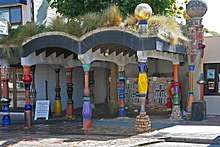
Public toilets have long been associated with graffiti, often of a transgressive, gossippy, or low-brow humorous nature (cf. toilet humour). The word latrinalia—from latrine (toilet) and -alia (a collection)—was coined to describe this kind of graffiti.[32] A famous example of such artwork was featured on the album cover of the satirical Tony Award Broadway musical Urinetown, using felt-tip pen scribblings.
As graffiti merged into street art, so some public street-level toilets began to make a feature of their visibility. The Hundertwasser toilet block is a colourful example in Kawakawa, New Zealand, designed by an Austrian artist and viewed as a tourist draw in a small town.
Drugs, vandalism and violent crime
Some public toilets are known for drug-taking and drug-selling, as well as vandalism. This type of criminal activity is associated with all "neglected, unsupervised buildings", not just toilets, and good cleanliness and maintenance, and ideally an attendant on the premises, can act as a protection against these problems.[33]
Violent crime inside public toilets can be a problem in areas where the rate of such crimes in general is very high. In South Africa for instance, many people have reported being afraid to use public toilets.[34] There have been several highly publicized murders in public toilets, such as the Seocho-dong public toilet murder case in South Korea in 2016. In the US, an infamous case was the murder of a 9-year-old boy in 1998 in a San Diego county public toilet.[35]
Anonymous sex
Before the gay liberation movement, public toilets were amongst the few places where men too young to enter gay bars legally could meet others who they knew with certainty to be gay.[36] Many, if not most, gay and bisexual men at the time were closeted, and almost no public gay social groups were available for those under legal drinking age.[37] The privacy and anonymity public toilets provided made them a convenient and attractive location to engage in sexual acts then.
Sexual acts in public toilets are outlawed in many jurisdictions (e.g. the Sexual Offences Act 2003 in the UK).[38][39][40] It is likely that the element of risk involved in cottaging makes it an attractive activity to some.[41][42]
Symbols in unicode
Unicode provides several symbols for public toilets.[43]
| Symbol | Code | Name | Value | Image |
|---|---|---|---|---|
| 🚹 | U+1F6B9 | MENS SYMBOL | men's restroom/washroom | |
| 🚺 | U+1F6BA | WOMENS SYMBOL | women's restroom/washroom | |
| 🚻 | U+1F6BB | RESTROOM | restrooms/washrooms or unisex restroom/washroom | |
| 🚼 | U+1F6BC | BABY SYMBOL | baby changing station | |
| ♿ | U+267F | WHEELCHAIR SYMBOL | disabled accessible facilities | |
| 🚽 | U+1F6BD | TOILET | restroom/washroom | |
| Source:[43][44] | ||||
Legislation
Employees' rights to use the toilet vary between jurisdictions.
United States
The Restroom Access Act is legislation several U.S. States passed that requires retail establishments with toilet facilities for employees to also allow customers to use the facilities if the customer suffers from an inflammatory bowel disease or other medical condition requiring immediate access to a toilet.
United Kingdom
In the United Kingdom, the Workplace (Health, Safety and Welfare) Regulations 1992 requires businesses to provide toilets for their employees,[45] along with washing facilities including soap or other suitable means of cleaning. The Workplace (Health, Safety and Welfare) Approved Code of Practice and Guidance L24, available from Health and Safety Executive Books, outlines guidance on the number of toilets to provide and the type of washing facilities associated with them.[46]
Local authorities are not legally required to provide public toilets, and while in 2008 the House of Commons Communities and Local Government Committee called for a duty on local authorities to develop a public toilet strategy,[47] the Government rejected the proposal.[48]
History
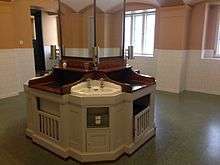
Public toilets were part of the sanitation system of ancient Rome, often in proximity to or as part of public baths (thermae).[49] By the Middle Ages public toilets became uncommon, with only few attested in Frankfurt in 1348, in London in 1383, and in Basel in 1455.[50]
In the early 19th century, large cities in Europe started installing public toilets: first in Paris, then in Berlin in 1820 and in London in 1851.[50]
George Jennings, the sanitary engineer, introduced public toilets, which he called "monkey closets", to the Crystal Palace for The Great Exhibition of 1851.[51] He also used the euphemism "halting station",[52] now in use in Indian English for a basic place to stay attached to a railway station. Public toilets were also known as "retiring rooms"[53] (cf "drawing room", from "to withdraw", and waiting room.)
Underground public toilets were introduced in the United Kingdom in the Victorian era, in built-up urban areas where no space was available to provide them above ground. The facilities were accessible by stairs, and lit by glass brick on the pavement. Local health boards often built underground public toilets to a high standard, although provisions were higher for men than women. Most have been closed as they did not have disabled access, and were more prone to vandalism and sexual encounters, especially in the absence of an attendant. A few remain in London, but others have been converted into alternative uses such as cafes, bars and even dwellings.
In the United States, concerns over public health and sanitation spurred the sanitarian movement during the late 1800s.[54] Reforms to standardize plumbing codes and household plumbing were advocated for; the intersection of advancements in technology and desire for cleanliness and disease-free spaces spurred the development of restrooms and toilets.
Facilities for women sometimes had a wider emphasis, providing a safe and comfortable private space in the public sphere. The Ladies Rest Room is one example of the non-euphemistic use of the term: literally, a place to rest.
A notable early example of a public toilet in the United States is the Old School Privy. The American architect Frank Lloyd Wright claimed to have "invented the hung wall for the w.c. (easier to clean under)" when he designed the Larkin Administration Building in Buffalo, New York in 1904.
Racial segregation
In parts of the United States, public toilets were subject to racial segregation, due to the Jim Crow laws prior to the Civil Rights Act of 1964. This segregation imposed significant restrictions on the lives of African-Americans.[55] Those who were able to afford cars could avoid the indignities of segregated trains and buses, but they faced the difficulty of finding a public toilet they were allowed to use. Courtland Milloy of the Washington Post recalled that on cross-country roadtrips in the 1950s his parents were reluctant to stop the car to allow the children to relieve themselves – it just wasn't safe.[56] One solution to this was to carry a portable toilet (a sort of bucket-like arrangement) in the trunk of the car.[57]
This treatment led to the creation of The Negro Motorist Green Book, an annually updated guidebook. Coping with discrimination on the road took some planning:
Uncle Otis had made this trip before, and he knew which places along the way offered "colored" bathrooms and which were better just to pass on by. Our map was marked and our route was planned that way, by the distances between service stations where it would be safe for us to stop.[58]
Once the traveler had found the correct "colored restroom", however, it could serve "as a respite from the insults of the white world",[59] akin to what is now called safe space.
Gallery

- Typical North American public toilet
.jpg) Public toilet at the Vienna State Opera has recorded music
Public toilet at the Vienna State Opera has recorded music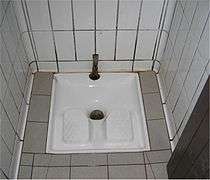 Roadside squat toilet near Toulouse, France
Roadside squat toilet near Toulouse, France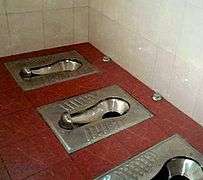 Squat toilets in Beijing, China
Squat toilets in Beijing, China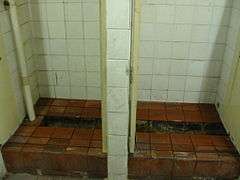 Old-style public toilet in a Hong Kong factory
Old-style public toilet in a Hong Kong factory.jpg) Roadside public toilet in Japan
Roadside public toilet in Japan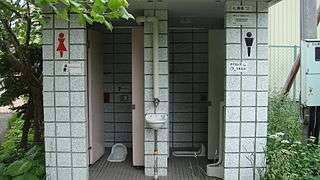 Public toilet at Jozankei Hot Springs, Hokkaido, Japan
Public toilet at Jozankei Hot Springs, Hokkaido, Japan Public toilets near Kullu, India
Public toilets near Kullu, India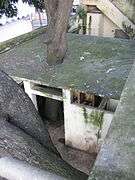 Public toilet near cinema in Bangalore, India
Public toilet near cinema in Bangalore, India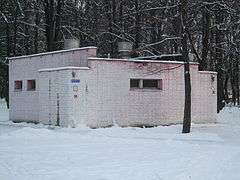 Public toilet in Kuskovo, near Moscow, Russia
Public toilet in Kuskovo, near Moscow, Russia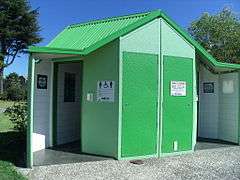 Public toilet in Pukekohe, New Zealand
Public toilet in Pukekohe, New Zealand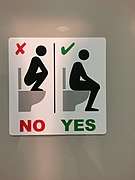 Instructions posted in women's, German public toilet
Instructions posted in women's, German public toilet Men's gents (restroom) in Harrods department store
Men's gents (restroom) in Harrods department store
See also
| Wikimedia Commons has media related to Public toilets. |
- National Public Toilet Map (in Australia)
- Sanitation
- Spray-and-vac cleaning, a method of professional cleaning
References
- ↑ "Away from home toilet charter" (PDF). British Toilet Association. Retrieved 21 March 2017.
- ↑ "Archived copy". Archived from the original on 2017-04-06. Retrieved 2017-04-06.
- ↑ BRYAN HILL (12 July 2015). "Money Does Not Stink: The Urine Tax of Ancient Rome". Ancient Origins. Retrieved 15 May 2018.
Vespasian's name is still attached to public urinals in France (vespasiennes), Italy (vespasiani), and Romania (vespasiene)
- ↑ Mulrooney, Thomas. "Public Toilets Around the World". Plumbworld News. Archived from the original on 1 November 2013. Retrieved 20 January 2014.
- ↑ "Clean sweep: How digital solutions like e-toilets are taking on open-defecation". https://www.hindustantimes.com/. 24 March 2018. Retrieved 6 April 2018. External link in
|work=(help) - 1 2 "Urilift pop-up urinals". Urilift. Retrieved 21 March 2017.
- ↑ "What are Changing Places Toilets?". Changing Places. Retrieved 21 March 2017.
- ↑ "Give us a (Loo) break!" (8 March 2010) Trade Union Congress <https://www.tuc.org.uk>
- ↑ "Occupational Safety and Health Administration, Standard Number: 1910.141(c)(1)(i)". United States Department of Labor. Retrieved 28 April 2017.
- ↑ US Public Health Mandates and the Restroom Problem in America, American Restroom Association, World Toilet Summit, Delhi, November 1, 2007
- ↑ "About the National Toilet Map". The National Toilet Map. Australian Government: Department of Health and Ageing. 2006. Retrieved 2006-04-14.
- ↑ "Should men's restrooms have diaper changing tables? New bill says yes". Retrieved 6 July 2014.
- ↑ Lamont, Peter (2004). The Rise of the Indian Rope Trick, (The Biography of a Legend) (1 ed.). Time Warner Books. ISBN 0-316-72430-0.
- ↑ Gruenstein, Peter (4 Sept 1975) Pay toilet movement attacks capitalism, The Beaver County Times, Retrieved October 19, 2010 (with sarcastic subtitle for 1975, "How about charging air for tires?")
- ↑ [Public toilets 'wiped out in parts of UK']
- ↑
- ↑ "Council could close 'cottaging' toilets in Lincoln city centre". BBC. 2 August 2014. Retrieved 20 December 2016.
- ↑ "Public toilets face closure amid sordid sex sessions". Loughborough Echo. 4 March 2009. Retrieved 20 December 2016.
- ↑
- ↑
- ↑
- ↑ Piha, Samuel; Räikkönen, Juulia (May 2017). "When nature calls: The role of customer toilets in retail stores". Journal of Retailing and Consumer Services. 36: 33–38. doi:10.1016/j.jretconser.2017.01.005.
- ↑ Harriet Agerholm (11 May 2018). "Starbucks chairman says coffee shop 'toilets are open to everyone'". The Independent. Retrieved 16 May 2018.
- ↑ Zlati Meyer (11 May 2018). "Starbucks changes bathroom policy after Philadelphia arrest: Anyone may use them". USA Today. Retrieved 16 May 2018.
- ↑ Michael, Jane; Michael Stern (1999-09-13). "Operators shouldn't get potty over bathroom symbols". Nation's Restaurant News. Archived from the original on 2008-06-17. Retrieved 2009-02-27.
- ↑ "Six steps to stop violence against schoolgirls, Document ACT 77/008/2007". Amnesty International. November 2007. Retrieved 2009-02-27.
- ↑ 2009 UNIFORM PLUMBING CODE, 412.3 (PDF). Ontario, California: International Association of Plumbing and Mechanical Officials. 2009. p. 34. ISSN 0733-2335. Archived from the original (PDF) on 2014-08-11. Retrieved 2014-04-11.
- ↑ La Ganga, Maria L (30 March 2016). "From Jim Crow to transgender ban: the bathroom as battleground for civil rights". The Guardian. Retrieved 24 October 2016.
- ↑ Devine, Shannon (2004-03-11). "Inclusive toilets". McGill Reporter. Retrieved 2009-02-27.
- ↑ Toilet Signs at Adept Safety Online (informative commercial site)
- ↑ Lancaster, Roger (21 May 2016). "Imagining the Socialist Bathroom". Jacobin. Retrieved 15 January 2017.
- ↑ Palazzolo, Rose. "Latrinalia - Learning From the Scrawls in the Bathroom". ABC News. Retrieved 30 October 2013.
- ↑ Greed, Clara (2007). Inclusive Urban Design: Public Toilets. Routledge. p. 255.
|access-date=requires|url=(help) - ↑ http://www.cbc.ca/radio/thecurrent/the-current-for-november-15-2016-1.3850427/it-s-not-safe-south-africans-fear-using-public-toilets-after-woman-murdered-1.3850509
- ↑ http://edition.cnn.com/US/9811/16/boy.killed.02/
- ↑ Prejudice and Pride: Discrimination Against Gay People in Modern Britain by Bruce Galloway; Published by Routledge, 1983; ISBN 0-7100-9916-9, ISBN 978-0-7100-9916-7.
- ↑ David Northmore (11 April 1998). "Finding private passion in a public place; Why is it that some gay men go in search of sexual encounters in lavatories?". The Independent.
- ↑ Galop.org.uk, Cottaging and cruising: your safety, your rights and the law.
- ↑ Kingston Hospital NHS Trust, Sex and the law.
- ↑ Sexual Offences Act 2003, part 1, paragraph 71,
- ↑ Public Sex/gay Space by William Leap; Published by Columbia University Press, 1999; ISBN 0-231-10691-2, ISBN 978-0-231-10691-7.
- ↑ Kirchick, James (1 November 2009). "Cruise Control". The Advocate. Archived from the original on 10 October 2009. Retrieved 22 October 2009.
- 1 2 Unicode.org, Transport and Map Symbols. Range: 1F680–1F6FF. (accessed 6 November 2012)
- ↑ Unicode.org, Miscellaneous Symbols. Range: 2600–26FF. (accessed 6 November 2012)
- ↑ Workplace (Health, Safety and Welfare) Regulations 1992
- ↑ Health and Safety Executive Books
- ↑ "The Provision Of Public Toilets" (PDF). House of Commons. Retrieved 20 January 2014.
- ↑ "Government Response to Public Toilet Provision" (PDF). www.gov.uk. Retrieved 20 January 2014.
- ↑ Heikki S. Vuorinen (2010): "Water, toilets and public health in the Roman era", in Water Science & Technology: Water Supply, pg.211
- 1 2 Peter Kasza:"Das große Latrinum: 155 Jahre öffentliche Toilette", in Der Spiegel, 22 June 2007
- ↑ Hibbert, Christopher (2008). The London Encyclopaedia. p. 668.
|access-date=requires|url=(help) - ↑ Andrews, Margaret. "Sanitary Conveniences and the Retreat of the Frontier: Vancouver, 1886-1926". British Columbian Quarterly (87). Retrieved 25 October 2016.
- ↑ Oxford Dictionary https://en.oxforddictionaries.com/definition/retiring_room. Retrieved 24 October 2016. Missing or empty
|title=(help) - ↑ Kogan, Terry S. “Sex-Separation in Public Restrooms: Law, Architecture, and Gender.” Michigan Journal of Gender & Law; Ann Arbor 14.1 (2007): 1–57. Print.
- ↑ Published in The Public Historian, ed. Randolph Bergstrom, Volume 27, Issue 4, Fall 2005, pages 11-44. Weyeneth, R. R. (2005). The architecture of racial segregation: The challenges of preserving the problematic past. The Public Historian, 27(4), 11-44. DOI: 10.1525/tph.2005.27.4.11
- ↑ Milloy, Courtland (June 21, 1987). "Black Highways: Thirty Years Ago We Didn't Dare Stop". The Washington Post. Retrieved October 24, 2016.
- ↑ Sugrue, Thomas J. "Driving While Black: The Car and Race Relations in Modern America". Automobile in American Life and Society. University of Michigan. Retrieved October 24, 2016.
- ↑ Wright, Gavin (2013). Sharing the Prize. Harvard University Press. pp. 75–76. ISBN 9780674076440.
- ↑ Molotch, ed. by Harvey; Norén, Laura (2010). Toilet. ; Public Restrooms and the Politics of Sharing. New York: New York University Press. ISBN 0814795897.
External links
- British Toilet Association Campaigning for Better Public Toilets for All
- American Restroom Association America's advocate for the availability of clean, safe, well designed public restrooms
- Australia's National Public Toilet Map shows the location of more than 14,000 public and private public toilet facilities across Australia.
- Public Toilets Database Locations of public toilets in 18 countries. New locations and comments can be added. Detailed information includes the geographic coordinates and quality of the facility.
- Needaloo The Uk Online Disabled Loo Locator
- PHLUSH Volunteer advocacy group for public toilets
